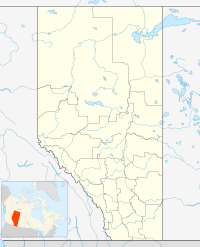Coutts, Alberta facts for kids
Quick facts for kids
Coutts
|
|
|---|---|
|
Village
|
|
| Village of Coutts | |

Coutts border crossing, into the US
|
|
| Motto(s):
The Gateway to Alberta
|
|

Location within County of Warner
|
|
| Country | Canada |
| Province | Alberta |
| Region | Southern Alberta |
| Planning region | South Saskatchewan |
| Municipal district | Warner |
| Incorporated | |
| • Village | January 1, 1960 |
| Area
(2021)
|
|
| • Land | 1.18 km2 (0.46 sq mi) |
| Elevation | 1,070 m (3,510 ft) |
| Population
(2021)
|
|
| • Total | 224 |
| • Density | 190.4/km2 (493/sq mi) |
| Time zone | UTC−7 (MST) |
| • Summer (DST) | UTC−6 (MDT) |
| Area code(s) | 403 / 587 |
| Highways | |
| Waterway | Milk River |
Coutts is a small village in southern Alberta, Canada. It is a very important port of entry into the U.S. state of Montana. This means it's a place where people and goods cross the Canada–United States border. It is one of the busiest border crossings in western Canada.
Coutts connects Alberta Highway 4 to Interstate 15 in the United States. This route is a major trade route called the CANAMEX Corridor. It helps move goods between Alberta, American states along I-15, and Mexico.
History of Coutts
The village of Coutts was named after William Burdett-Coutts. He was a railroad official who helped with the development of the area.
In 2004, a special joint border facility opened in Coutts. This facility is shared by both Canadian and American federal authorities. It helps make border crossings smoother and more efficient for everyone.
People and Population
Coutts is a small community with a changing population over the years.
How Many People Live Here?
|
|||||||||||||||||||||||||||
In the 2021 Canadian census, Statistics Canada counted the population of Coutts. There were 224 people living in the village. This was a small decrease from its population of 245 in 2016.
How Crowded is Coutts?
The village covers a land area of about 1.18 square kilometers (0.46 square miles). In 2021, this meant there were about 190 people living in each square kilometer. This is called the population density.


